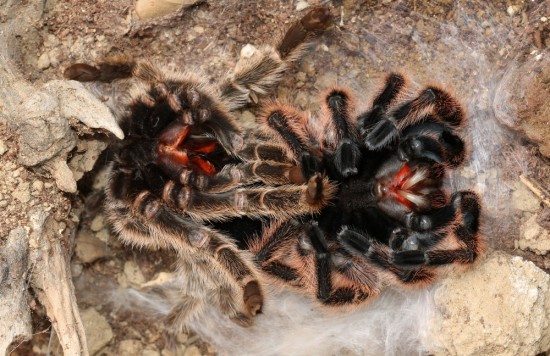
Hamsters are usually free of parasites, but occasionally they can be exposed to and become carriers of mites. Mites are tiny, black parasites that can cause much discomfort for your pets. They live in the hair follicles in your pet's fur. If left untreated, mites can spread to and infect other hamsters and can also lead to mange. (Mange is a skin condition that is characterized by redness, intense itching, skin irritation and hair loss).
Hamsters can get mites from several sources. The most common is when they are in contact with an infested hamster. They can also get it when bedding is used that contains mites. Hay (which is used for food) can also be infested. A good practice is to inspect any new package of bedding or food before using it.
Symptoms include scratching/itching, sore spots, loss of fur. Mites can be nearly impossible to see, but it is sometimes helpful to check for them by using a flashlight in a darkened room. Rubbing a white paper towel on your pet can also produce results. Look for tiny black specks that move when you disturb the fur with your finger or a paper towel. (Fleas are another parasite that can have the same symptoms, but fleas are larger and much easier to spot than mites.) If you simply cannot be certain, contact your veterinarian and have him examine your pet for confirmation.
Treatment consists of an anti-mite spray that is designed for birds and small animals. This is an over-the-counter compound and can be purchased at most pet stores. Make sure that you cover and protect your hamster's eyes while you are using the spray to treat him. You must also remove all bedding from your hamster's cage and wash the cage well. Spray the cage well with the anti-mite spray according to the directions on the packaging.
At the first sing of mites, quarantine the affected hamster in order to keep the mites from spreading. Keep him in a separate cage and also a separate room. Do not reintroduce him back into the general population until after you are completely sure the hamster is free of mites. (If the hamster is away from the other hamsters long enough, you may have to take care and slowly reintroduce him back into the general population.)
It is important to find the source of the contamination. Check any unused bedding for mites, and if in doubt, dispose of it and purchase a new bag of bedding material. Check food sources and other hamsters. If you have recently purchased your hamster, notify the store where you purchased him. If you find that you have bedding or hay that has been contaminated, contact the retailer where you purchased it and let them know about it. This will help them control the outbreak.
Finally, do not be concerned about "catching" mites from your hamster. Mites do not care for humans - they much prefer animals with fur - but basic precautions, such as hand washing, are always a good idea.
 Hints And Tips On Allocating A Personal Space To Your Dog
Hints And Tips On
Hints And Tips On Allocating A Personal Space To Your Dog
Hints And Tips On
 Tarantulas And Moulting
Tarantulas And Mo
Tarantulas And Moulting
Tarantulas And Mo
 Making Your Own Dog Treats
Making Your Own D
Making Your Own Dog Treats
Making Your Own D
 Let's Know More on Dog Wash and Dog Hygiene
Let's Know More on Dog Wash and Dog Hygiene
Let's Know More on Dog Wash and Dog Hygiene
Let's Know More on Dog Wash and Dog Hygiene
 Giant Schnauzer Hereditary Health And Longevity
Giant Schnauzer H
Giant Schnauzer Hereditary Health And Longevity
Giant Schnauzer H
Copyright © 2005-2016 Pet Information All Rights Reserved
Contact us: www162date@outlook.com